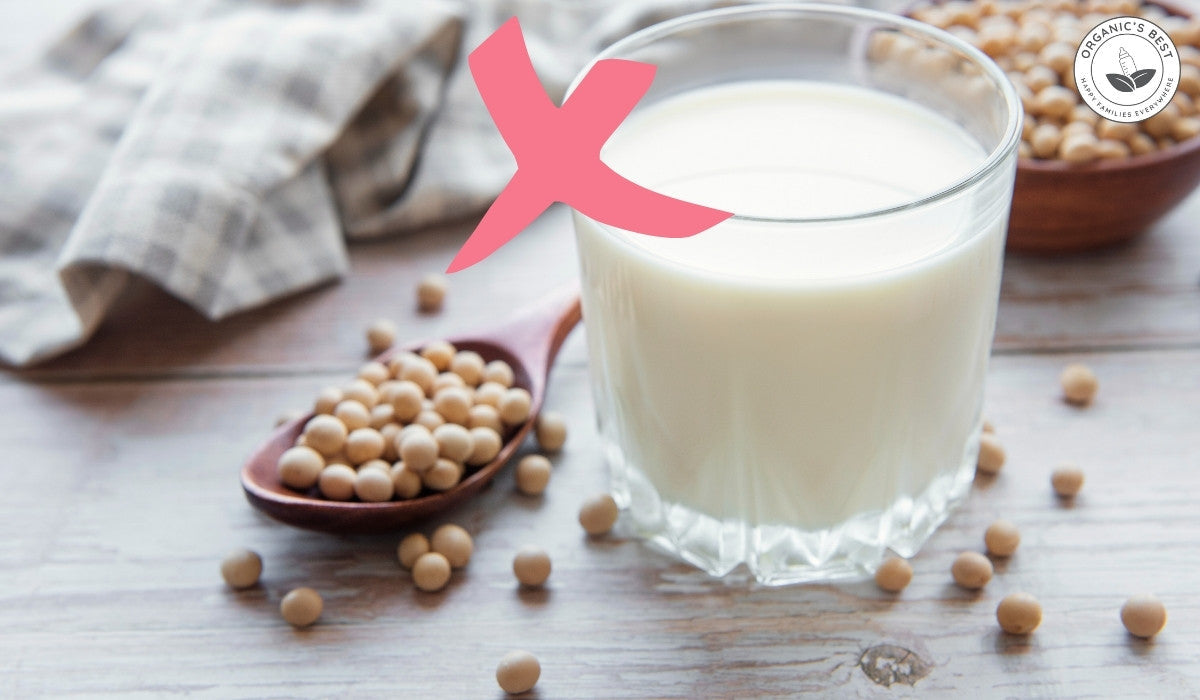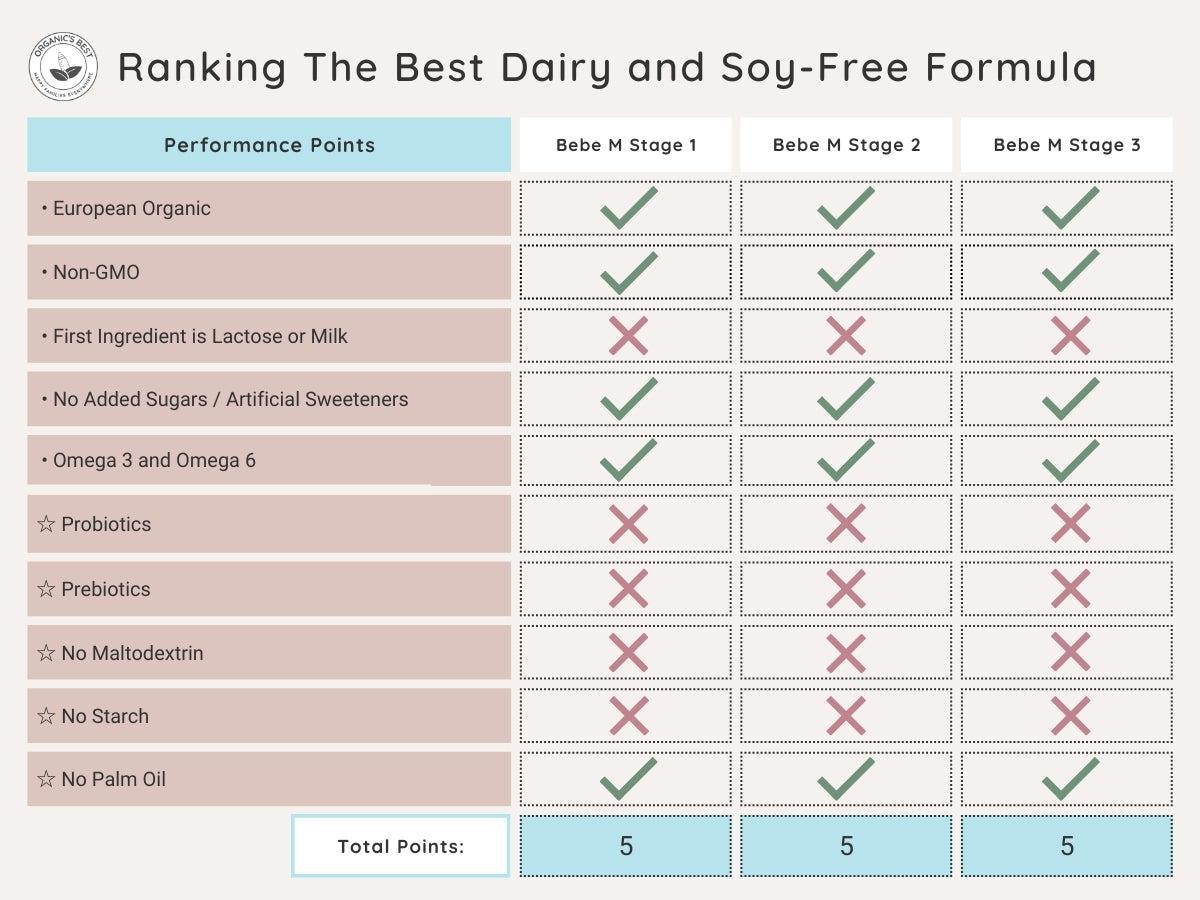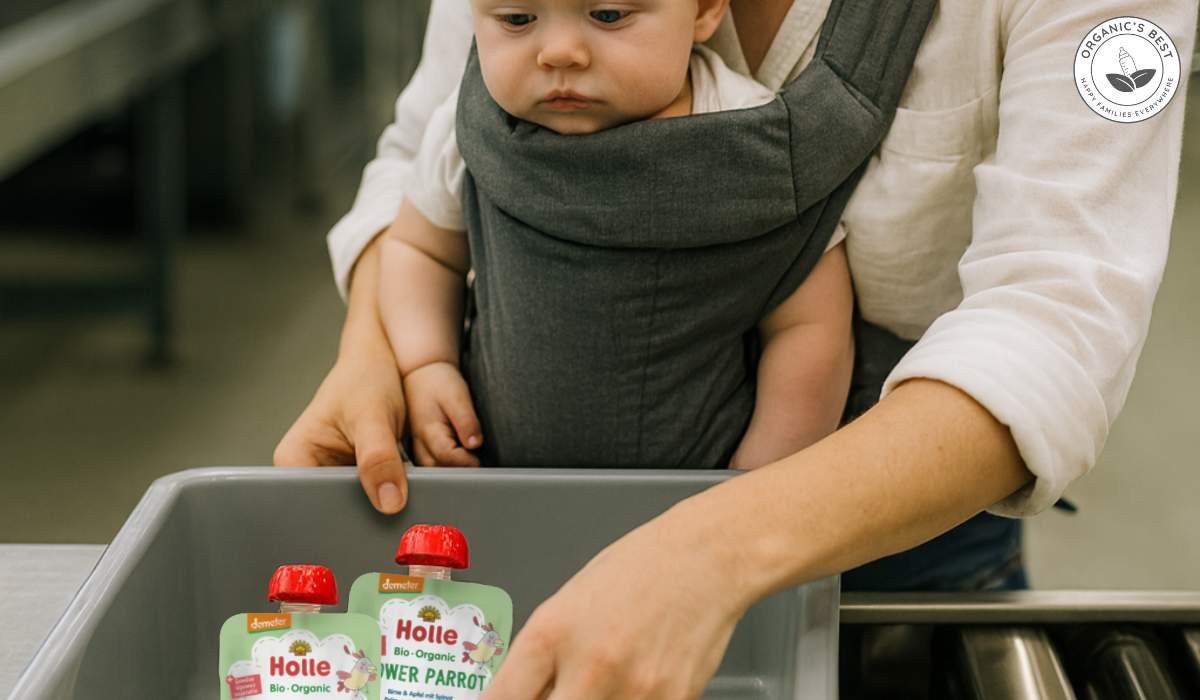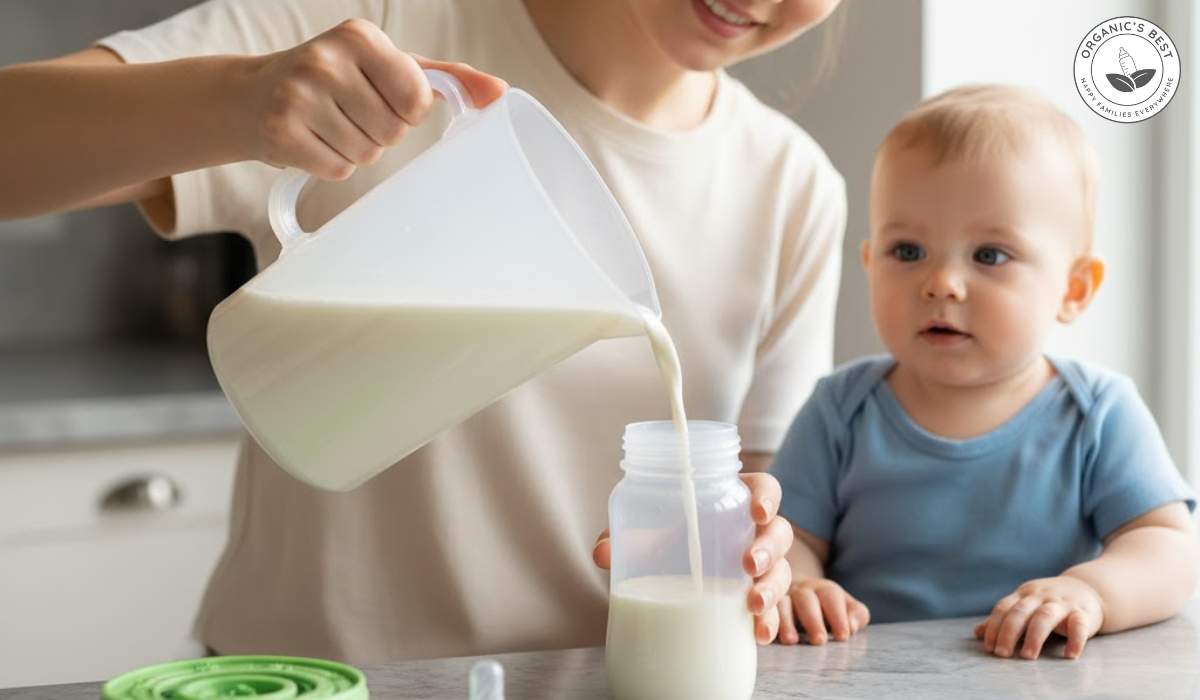Click to Get 2 FREE Boxes/Cans
Only New Customers! Click HERE to Get 2 Extra Boxes/Cans for Free With Your First Order.
BABY FORMULA
Offering new parents top-quality European infant formula from renowned brands like HiPP, Holle, Kendamil, and more. If you’re uncertain about which product to choose, our Formula Finder can help you make the best decision for your baby.
Baby Food
Offering new parents a premium selection of European baby foods, including jars, pouches, cereals, and snacks from esteemed brands like HiPP and Holle.
The Best Dairy and Soy-Free Formula
by Agustina Fernandez January 31, 2024 13 min read

Our knowledge about infant nutrition is constantly evolving. We've watched many new types of formulas grow in popularity, from goat's milk formulas, to soy-based formulas and more. One of the latest additions is vegan baby formula made with hydrolyzed rice protein.
Today, we understand that a one-size-fits-all approach doesn't always work, which is why baby food companies focus on diversifying the infant formula market, giving parents a range of products to choose from if a standard cow's milk formula isn't suitable for their little one. We know that with so many options available, making the right choice can seem challenging.
This is especially true if your baby has a diagnosed food allergy like cow's milk protein allergy (CMPA) or soy allergy or if they are lactose intolerant, which may require them to rely on a more specialized diet. That's where BebeM vegan baby formula comes in!
In this article, we'll explain why you would choose a dairy and soy-free formula and provide an in-depth guide to selecting the best one by comparing all 3 stages of Bebe M vegan formula. To help you make an informed decision, we focus on evidence-backed benefits and provide an unbiased ranking based on the pros and cons of each product!
Table of contents
- Ranking Bebe M’s Best Milk and Soy-Free Formula
- What formulas are dairy and soy-free? Our top 3 picks from Bebe M!
- #1 Bebe M Stage 1
- #2 Bebe M Stage 2
- #3 Bebe M Stage 3
- Reasons to Choose a Soy or Dairy-Free Formula
- What formula is best for cow milk and soy allergy?
- What baby formula does not contain dairy?
- What formula is best for dairy intolerance?
- Why do soy-based non-dairy formulas get a bad rep?
- Tips for Preparing Bebe M Formula
- Scientific References
Ranking Bebe M’s Best Milk and Soy-Free Formula
We're here to help you on your formula-finding journey! To do so, we have spent hours researching formulas, scrutinizing scientific studies, and analyzing ingredient lists so that we can give trustworthy and reliable recommendations based on the latest scientific findings in infant nutrition.
We encourage you to check out our "How We Review Page" for more info on our standards for rating each product.
To make our ranking system as comprehensive as possible, we have evaluated each baby formula based on five key criteria: European organic certification, non-GMO ingredients, lactose or milk as the primary ingredient, no added sugars or artificial sweeteners, and the inclusion of ARA & DHA.
We've also awarded bonus points for the inclusion of probiotics and prebiotics and the absence of maltodextrin, starch, and palm oil. Each performance category is assigned 1 point for a maximum of 10 points in total.

What Formulas are Dairy and Soy-Free? Our Top 3 Picks from Bebe M!
Before we dive into all that this baby formula has to offer, we should note that this product falls under the category of "Foods for special medical purposes"(FSMPs) due to the inclusion of hydrolyzed rice protein.
FSMPs may only be used under medical supervision and in cases where standard cow's milk formula is not a viable option.
If you think that Bebe M might be a good fit for your baby, it is important to consult your pediatrician before starting them on this dairy-free formula.
Despite the fact that hydrolyzed rice formulas are considered FSMPs, that does not mean that they are unsafe or nutritionally incomplete. It just means that most healthy babies without special food requirements can tolerate dairy formula just fine.
Excitingly, our review of recent research suggests that rice protein formulas are a promising non-dairy formula alternative to soy milk formulas, with pediatric scholars in France saying that these formulas "may be considered as a part of a trend towards plant-based sources of protein, which may be beneficial on human health, mortality, and may have an impact on the environment, hence its potential growing use in infants and children."
But for now, they are only being recommended for infants with dietary restrictions such as a milk protein allergy. Now, let's get into some of the exciting nutritional features of Bebe M infant formula!
Leading Qualities of Bebe M Soy and Dairy-Free Formula
Starting off strong, we were pleased to find that Bebe M exceeds our expectations in organic excellence. Not only does it tick the box for carrying the coveted EU organic certification, but you will also find the AB France organic logo on this product. This signifies that Bebe M meets a quality that respects both European and French organic formula regulations.
In line with European standards, Bebe M is also made without the use of genetically modified ingredients (GMOs).
Since Bebe M is both soy and dairy-free, it was no surprise to us that the ingredients were a little different than what you would find in conventional infant formula. In lieu of lactose or milk, this formula has a base of hydrolyzed rice proteins, plant-based oils, and complementary carbohydrates, including corn maltodextrin and corn starch.
Excluding milk or lactose in a conventional formula would definitely raise alarm bells, but since this formula is uniquely made for little ones with special dietary restrictions, we're not worried about the exclusion of these dairy products.
We were equally thrilled to see that Bebe M does not contain added sugars like corn syrup solids or artificial sweeteners.
Another highlight of Bebe M's soy-free and dairy-free formula is the inclusion of Omega-3 and Omega-6 essential fatty acids in the form of DHA, ALA and LA, all of which have many health benefits. DHA contributes to brain development and function, while ALA and LA support heart health.
Bonus Points Awarded to Bebe M ☆
We have noted in our reviews that many infant formulas now include prebiotics and probiotics, which are often sourced from milk or other dairy products. While this can be beneficial for gut health, Bebe M has omitted these ingredients as a way to preserve its plant-based benefits.
Moreover, while the inclusion of maltodextrin is sometimes considered a negative, in the case of rice-based vegan formula, we've found through our research that it is a useful ingredient. This is because an infant formula needs carbohydrates, just like breast milk. Since Bebe M is a soy-free and dairy-free formula, they have opted for maltodextrin.
Corn starch is also included in this formula as a complimentary carbohydrate, but we have noticed that it serves multiple purposes. Our findings show that the organic starch in this formula also acts as a thickener to help keep food in the stomach, which makes this formula beneficial for babies who experience excessive regurgitation.
Another natural thickening agent that we found in this formula is fibre-rich carob gum, which helps keep food in the tummy and promotes regular bowel movements.
Notably, there are reports of some parents finding that this formula flows slower than others due to its thick texture. To prevent this issue, we recommend using a wide-mouth nipple.
On the topic of texture, this formula is no doubt different from others due to the addition of coconut oil and rice protein hydrolysate powder, which some parents have compared to "wet sand". While this may sound unappealing, it's a normal feature of hydrolyzed plant proteins, and babies generally accept and enjoy this formula.
Lastly, we give this formula points for excluding palm oil, which is known to cause tummy troubles for some babies and is often sourced unsustainably. Instead, this formula contains a blend of coconut oil, sweet almond oil, sunflower oil, and rapeseed oil.
#1 Bebe M Stage 1 - Best Dairy-Free Soy-Free Formula for Infants<
Recommended For:
This nutritionally complete formula is recommended for babies 0-6 months with dairy allergies, lactose intolerance and excessive regurgitation. Stage 1 is made to provide essential nutrients to your newborn if breast milk or milk-based formulas are not an option.
Pros ✔️
- EU and AB France organic certifications
- Made with 100% plant-based ingredients
- Contains easily digestible hydrolyzed rice protein
- Thickened with carob gum and corn starch to help combat excessive regurgitation
- Contains a palm oil free blend as a source of essential fats
- Free from common allergens, including milk or dairy products, gluten, soy, and nuts
Cons ❌
- No probiotics or prebiotics
- Has a thick texture that can be difficult to mix
-
Has a slightly bitter taste due to rice protein hydrolysate
#2 Bebe M Stage 2 - Best Non-Soy, Non-Dairy Formula for Weaning
Recommended For:
Stage 2 of Bebe M is recommended for babies 6-10 months with dairy allergies, lactose intolerance and excessive regurgitation. Stage 2 is made to be used alongside solid foods as part of a weaning diet to support healthy growth.
Pros ✔️
- EU and AB France organic certifications
- Made with 100% plant-based ingredients
- Contains easily digestible hydrolyzed rice protein
- Thickened with carob gum and corn starch to help combat excessive regurgitation
- Contains a palm oil free blend as a source of essential fats
- Free from common allergens, including milk or dairy products, gluten, soy, and nuts
Cons ❌
- No probiotics or prebiotics
- Has a thick texture that can be difficult to mix
- Has a slightly bitter taste due to rice protein hydrolysate
#3 Bebe M Stage 3 - Best Non-Dairy, Non-Soy Formula for Toddlers
Recommended For:
This formula is recommended for infants 10-36 months with dairy allergies, lactose intolerance and excessive regurgitation. Stage 3 is a plant-based formula made to support the nutritional transition from infancy to early childhood.
Pros ✔️
-
EU and AB France organic certifications
-
Made with 100% plant-based ingredients
-
Contains easily digestible hydrolyzed rice protein
-
Thickened with carob gum and corn starch to help combat excessive regurgitation
-
Contains a palm oil free blend as a source of essential fats
-
Free from common allergens, including milk or dairy products, gluten, soy, and nuts
Cons ❌
-
No probiotics or prebiotics
-
Has a thick texture that can be difficult to mix
-
Has a slightly bitter taste due to rice protein hydrolysate
What Parents Say 💬"The best formula out there. Thick and great for babies who have acid reflux and spit up." - Anna Malyar "I know this is a very high quality product but my daughter wouldn't drink it. It also had difficulty passing through the nipple because the formula didn't mix that well." - Chelsea Hall |
Reasons to Choose a Soy or Dairy-Free Formula
Now that we have covered the pros and cons of Bebe M's dairy-free options let's discuss why some parents are turning to hydrolyzed rice infant formulas as opposed to cow's milk or soy-based infant formulas.
Cow's Milk Protein Allergy (CMPA)
First up is a CMPA, which is a food allergy that can manifest early in life and is estimated to affect around 2 to 3% of infants in developed countries.
While this condition can be unpleasant, thankfully, most children outgrow by the time they hit their first birthday. Until then, some babies with CMPA have been recommended a plant-based milk formula by their physician.
There are two different types of cow's milk protein allergies, which notably cause different bodily reactions:

1) IgE-mediated: One reaction is quick, happening within an hour of drinking the milk. This type is often caused by an immunoglobulin called IgE, which is part of the baby's defence system.
It's usually easier to spot this kind of reaction because it causes common allergy symptoms, like rashes or trouble breathing. It can also be easily diagnosed through a blood test.
In rare cases, a child with CMPA may experience an extreme reaction called Anaphylaxis, which is caused by IgE. This reaction can be life-threatening and, therefore, requires immediate medical attention.
2) Non IgE-mediated: The other reaction is slower and can take hours or even days to show up. This kind isn't caused by IgE, so it's a bit trickier to notice and diagnose because its symptoms, like tummy trouble or eczema, are not often associated with an allergic reaction.
Symptoms of CMPA can include:
- Rashes
- Wheezing
- Facial swelling
- Vomiting
- Fussiness
- Diarrhea
- Blood in the stool
Lactose Intolerance
Lactose intolerance is another reason to choose a plant-based formula. This condition refers to the inability to digest lactose, the primary sugar found in cow's milk-based formula and dairy products, due to a deficiency or absence of the enzyme lactase.
We wanted to note that there is a difference between a milk allergy and milk intolerance. The biggest difference is that a milk allergy involves an immune system response. Additionally, an intolerance typically results in delayed symptoms, while allergies can cause immediate and/or delayed reactions.
Lactose intolerant symptoms can include:
- Gas
- Bloating
- Diarrhea
- Nausea
Soy Allergy
A soy allergy occurs when an infant's immune system mistakenly identifies proteins found in soy as harmful substances. It is one of the most common food allergies in infants and young children.
While soy-based formulas have been a popular choice amongst parents seeking a vegan or plant-based product, they may not be the best option for babies who are allergic to cow's milk formula, as soy allergies often co-occur with CMPA.
Symptoms of allergy to soy can include:
- Skin reactions
- Vomiting
- Diarrhea
- Respiratory reactions such as sneezing, coughing or wheezing
What Formula is Best for Cow Milk and Soy Allergy?
As mentioned above, children who have CMPA, often also react to soy proteins. For this reason, it may be necessary to choose a formula that is free of both allergens.
In such cases, the first choice for pediatricians is typically to recommend an extensively hydrolyzed milk formula. However, an amino acid-based formula or rice-based formula may also be suggested depending on the severity of the allergy.
Bebe M is one of the leading baby food brands that are currently offering a soy and dairy free formula alternative. Its base of organic, plant-based ingredients earns it a top spot on our list of the best non-dairy and non-soy infant formula.
Since hydrolyzed rice protein is considered an FSMP, Bebe M should only be used when a standard baby formula is not suitable and after assessment by a pediatrician.
What Baby Formula Does Not Contain Dairy?
There are a number of dairy-free baby formula options which are made with plant-based ingredients. This includes soy-based formula and hydrolyzed rice formulas. We recommend the latter since babies who are sensitive to dairy may also be sensitive to soy. If you are in the market for a hydrolyzed rice formula, Bebe M is a popular choice!
What Formula is Best for Dairy Intolerance?
Dairy intolerance is a broad term that can refer to lactose intolerance, a sensitivity to dairy, or CMPA. Depending on which of these conditions your baby has, the infant formula your pediatrician recommends will vary. The best formula will be the one that your pediatrician suggests to address your baby's specific dietary needs.
Why do Soy-Based Non-Dairy Formulas Get a Bad Rep?

While a soy-based formula is a relatively popular choice for those seeking dairy-free or lactose-free formula, there are some concerns linked to these products.
The main concern is that they contain isoflavones, a compound chemically similar to estrogen. This has raised questions about how soy formulas may affect infant development in terms of hormonal health and thyroid activity.
Following these concerns, a study conducted at Children’s Hospital of Philadelphia concluded that "relative to girls fed cow-milk formula, those fed soy formula demonstrated tissue- and organ-level developmental trajectories consistent with response to exogenous estrogen exposure.".
While the subtle differences detected may not have any impact on long-term health, further research is needed to evaluate the full effects of soy formulas on child development.
Additionally, soy proteins contain high levels of phytates, which bind with certain minerals like zinc, calcium, iron, and magnesium, and as a result, the body eliminates them without ever being absorbed.
This can potentially lead to mineral deficiencies in infants since most of their nutrients come from baby formula during the first year of life.
While none of this is a cause for immediate concern, these findings do emphasize the need for additional research into soy-based formulas.
Tips for Preparing Bebe M Formula
Since we mentioned that the texture of Bebe M is slightly different than a standard formula, we wanted to provide some tips and tricks on how to successfully prepare Bebe M's organic formula.
Taste and Texture of Bebe M Formula
The first thing to note is that the base of rice protein hydrolysate does cause this baby formula to have a slightly bitter taste, although most babies accept and enjoy it just like any standard formula.
If your little one doesn't love Bebe M at first, we recommend giving them time to allow their taste buds to adapt to the new taste and texture.
On top of this, do not be alarmed if your Bebe M formula appears to be a different color than what you're used to. The beige/greyish colour is completely normal and expected due to the organic rice protein hydrolysate.
It's also not uncommon for Bebe M to have a wet, sandy texture, which is caused by mixing powdered ingredients with cold-pressed vegetable oils. The baby formula may clump together due to the fineness of the protein hydrolysate powder.
Importantly, none of these attributes lessen the benefits of this baby formula, and we have tips on how to make preparing it easier up next!
Preparing Bebe M Formula
Due to the inclusion of organic coconut oil, you may find small white particles (coconut shavings) while mixing Bebe M formula. But not to worry! After mixing the formula with hot water and shaking the baby bottle, these particles should dissolve.
To help with this process, add the powder and then the water at 40°C. With that being said, we do recommend using teats with larger holes when prepping this formula. In our experience, we've found that a 3-speed teat typically works well with this formula!
Finally, like with any standard formula, a prepared bottle of Bebe M formula should be fed to babies at around 37°C and used within 1 hour once feeding has begun. If you are not feeding your little one right away, then it is good for up to 2 hours at room temperature.
Conclusion on Baby Formula Without Soy and Dairy
A dairy and soy-free formula isn't going to work for every baby, but if your little one has unique dietary needs that warrant a specialized diet, then Bebe M formula could be the answer.
Many parents and pediatricians alike are impressed by Bebe M's nutrient-rich, organic formulation. Despite having to rely on alternative ingredients, it remains free from allergens, is easily digestible and packed with nutrients.
It is for this reason that Bebe M formula has come out on top in our quality assessment. So, if you are on the hunt for a soy and dairy-free formula, you've landed in the right place! Just remember to consult your pediatrician prior to making any changes to your baby's diet.
Scientific References
- Adgent, M. A., Umbach, D. M., Zemel, B. S., Kelly, A., Schall, J. I., Ford, E., James, K., Darge, K., Botelho, J. C., Vesper, H. W., Chandler, D. W., Nakamoto, J. M., Rogan, W. J., & Stallings, V. A. (2018). A longitudinal study of Estrogen-Responsive tissues and hormone concentrations in infants fed soy formula. The Journal of Clinical Endocrinology & Metabolism, 103(5), 1899–1909.
- Clouard, C., Bourgot, C. L., Respondek, F., Bolhuis, J., & Gerrits, W. (2018). A milk formula containing maltodextrin, vs. lactose, as main carbohydrate source, improves cognitive performance of piglets in a spatial task. Scientific Reports, 8(1).
- Djuričić, I., & Calder, P. C. (2021). Beneficial outcomes of omega-6 and omega-3 polyunsaturated fatty acids on human health: an update for 2021. Nutrients, 13(7), 2421.
- Dupont, C., Bocquet, A., Tomé, D., Bernard, M. A., Campeotto, F., Dumond, P., Essex, A., Frelut, M., Guénard-Bilbault, L., Lack, G., Linglart, A., Payot, F., Taı̈Eb, A., & Kalach, N. (2020). Hydrolyzed Rice Protein-Based Formulas, a vegetal alternative in cow’s milk allergy. Nutrients, 12(9), 2654.
- National Academies Press (US). (2004). Comparing Infant Formulas with Human Milk. Infant Formula - NCBI Bookshelf.
- Setchell, K. D., Zimmer-Nechemias, L., Cai, J., & Heubi, J. E. (1997). Exposure of infants to phyto-oestrogens from soy-based infant formula. The Lancet, 350(9070), 23–27.
Disclaimer:
Please be aware that this information is based on general trends in babies, and it is not medical advice. Your doctor should be your first source of information and advice when considering any changes to your child’s formula and when choosing your child’s formula. Always consult your pediatrician before making any decisions about your child’s diet or if you notice any changes in your child. Breastfeeding is the best nutrition for your baby because breast milk provides your child with all the essential nutrients they need for growth and development. Please consult your pediatrician if your child requires supplemental feeding. |
Agustina Fernandez
Dr. Agustina Fernandez earned her medical degree from the prestigious Universidad Nacional de Córdoba, Argentina. With a deep-rooted passion for pediatrics, Dr. Fernandez is currently on the path to specializing in children's healthcare. Recently, she has delved into the vital field of infant nutrition. Her research interests include breastfeeding, infant formula, and baby food in little ones’ formative years. Dr. Fernandez's commitment to this area of study underscores her dedication to ensuring the health and well-being of children from their earliest days.
Leave a comment
Comments will be approved before showing up.
Also in Organic Infant Nutrition and Health Blog

Everything You Need To Know About Winter Pregnancy: Essential Tips for Moms-to-be
by Agustina Fernandez December 16, 2025 8 min read
Read More
Can You Bring Baby Food Pouches on a Plane? Essential Tips for Parents
by Agustina Fernandez December 09, 2025 7 min read
Read More
The Formula Pitcher: Is It Safe To Make A Whole Pitcher Of Baby Formula?
by Agustina Fernandez December 02, 2025 8 min read
Read More
Reviewed by Dr. Bardha Citaku, MD
-

Dr. Bardha Citaku: Medical Reviewer of Organic's Best Blog
Dr. Bardha Citaku completed her medical studies at the University of Prishtina in Kosovo, where she began her journey into the field of medicine. She has since developed a career in medical research, contributing to projects with notable organizations, including the World Health Organization (WHO).
